University Essay: Health and Social Exclusion in Ireland - Analysis
VerifiedAdded on 2021/04/24
|11
|3500
|42
Essay
AI Summary
This essay provides a comprehensive exploration of health and social exclusion in Ireland, examining the intricate relationship between poverty, social determinants, and health inequalities. It delves into the historical context of poverty, differentiating between absolute and relative poverty, and highlights the significant impact of social exclusion on various age groups. The essay emphasizes the role of social determinants, such as housing, income, and access to healthcare, in shaping health outcomes, and it underscores the importance of a life course perspective in understanding how these factors influence health from birth to death. It discusses the specific challenges faced by marginalized groups, including the elderly and those in rural areas, and calls for strategies focused on health equity, including investment in public health resources and the adoption of evidence-based recommendations to mitigate poverty and improve health outcomes. The essay also references studies and data to support its arguments, highlighting the persistent gaps in health and the need for proactive interventions to address the underlying causes of health inequalities in Ireland.
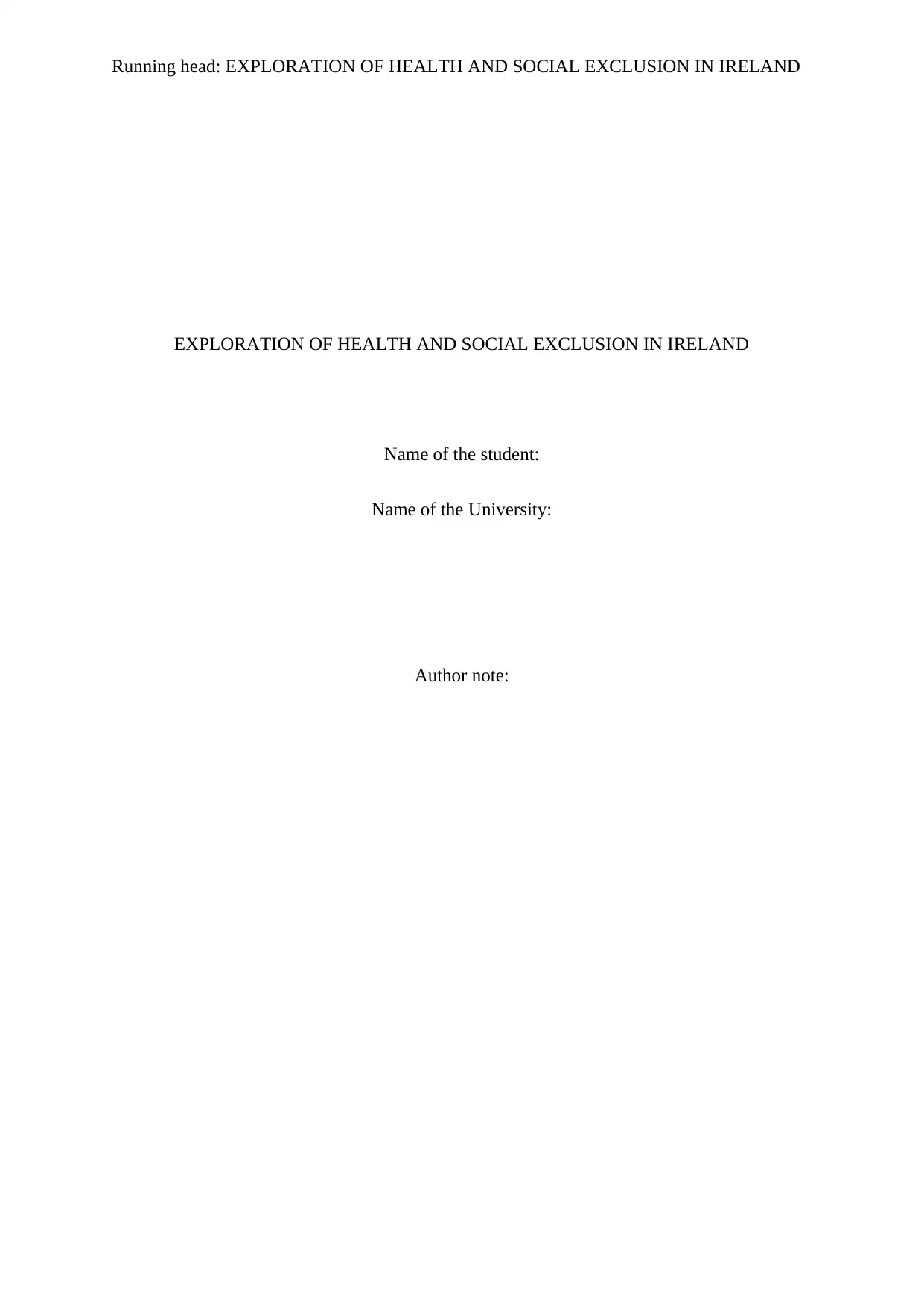
Running head: EXPLORATION OF HEALTH AND SOCIAL EXCLUSION IN IRELAND
EXPLORATION OF HEALTH AND SOCIAL EXCLUSION IN IRELAND
Name of the student:
Name of the University:
Author note:
EXPLORATION OF HEALTH AND SOCIAL EXCLUSION IN IRELAND
Name of the student:
Name of the University:
Author note:
Paraphrase This Document
Need a fresh take? Get an instant paraphrase of this document with our AI Paraphraser
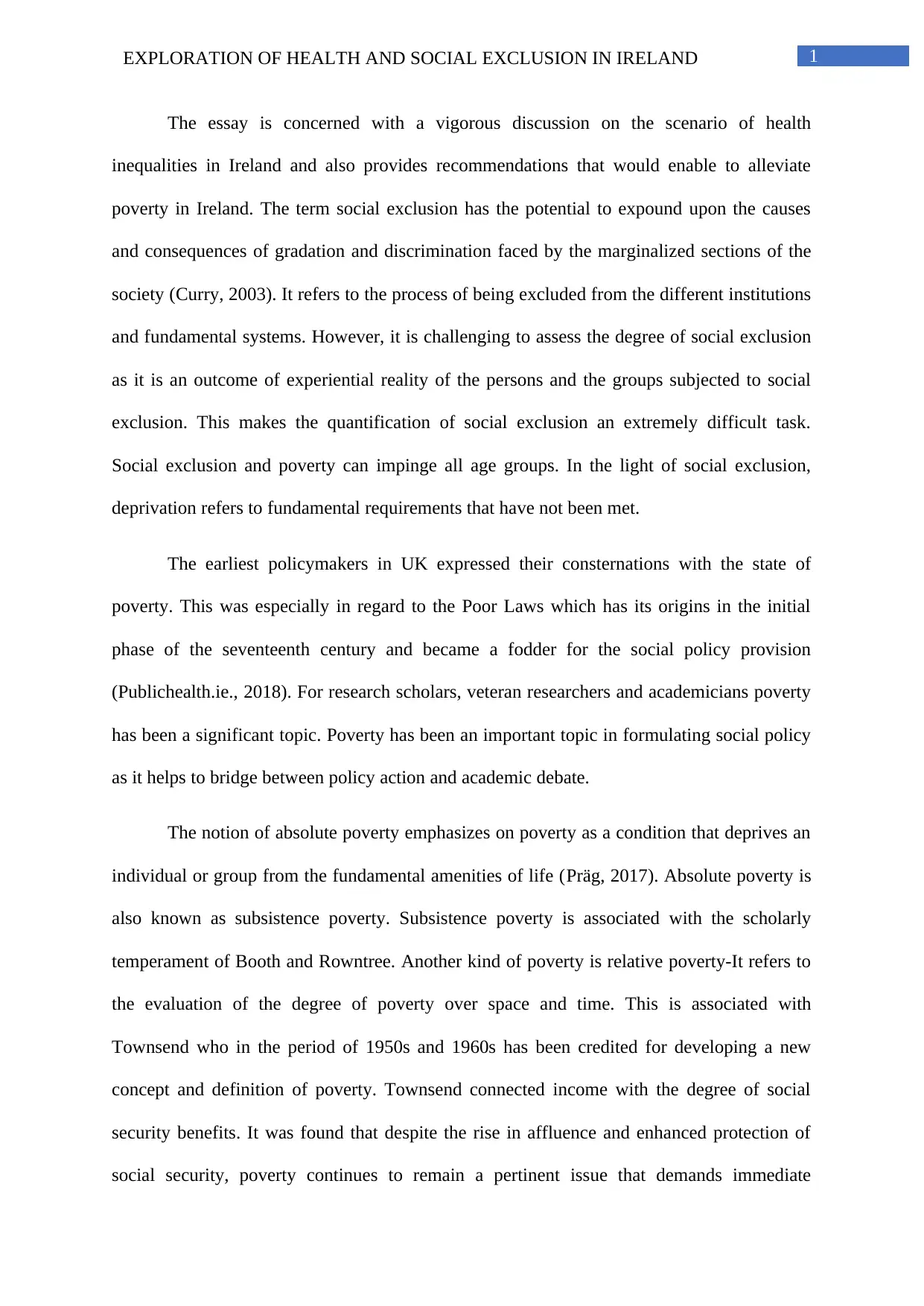
1EXPLORATION OF HEALTH AND SOCIAL EXCLUSION IN IRELAND
The essay is concerned with a vigorous discussion on the scenario of health
inequalities in Ireland and also provides recommendations that would enable to alleviate
poverty in Ireland. The term social exclusion has the potential to expound upon the causes
and consequences of gradation and discrimination faced by the marginalized sections of the
society (Curry, 2003). It refers to the process of being excluded from the different institutions
and fundamental systems. However, it is challenging to assess the degree of social exclusion
as it is an outcome of experiential reality of the persons and the groups subjected to social
exclusion. This makes the quantification of social exclusion an extremely difficult task.
Social exclusion and poverty can impinge all age groups. In the light of social exclusion,
deprivation refers to fundamental requirements that have not been met.
The earliest policymakers in UK expressed their consternations with the state of
poverty. This was especially in regard to the Poor Laws which has its origins in the initial
phase of the seventeenth century and became a fodder for the social policy provision
(Publichealth.ie., 2018). For research scholars, veteran researchers and academicians poverty
has been a significant topic. Poverty has been an important topic in formulating social policy
as it helps to bridge between policy action and academic debate.
The notion of absolute poverty emphasizes on poverty as a condition that deprives an
individual or group from the fundamental amenities of life (Präg, 2017). Absolute poverty is
also known as subsistence poverty. Subsistence poverty is associated with the scholarly
temperament of Booth and Rowntree. Another kind of poverty is relative poverty-It refers to
the evaluation of the degree of poverty over space and time. This is associated with
Townsend who in the period of 1950s and 1960s has been credited for developing a new
concept and definition of poverty. Townsend connected income with the degree of social
security benefits. It was found that despite the rise in affluence and enhanced protection of
social security, poverty continues to remain a pertinent issue that demands immediate
The essay is concerned with a vigorous discussion on the scenario of health
inequalities in Ireland and also provides recommendations that would enable to alleviate
poverty in Ireland. The term social exclusion has the potential to expound upon the causes
and consequences of gradation and discrimination faced by the marginalized sections of the
society (Curry, 2003). It refers to the process of being excluded from the different institutions
and fundamental systems. However, it is challenging to assess the degree of social exclusion
as it is an outcome of experiential reality of the persons and the groups subjected to social
exclusion. This makes the quantification of social exclusion an extremely difficult task.
Social exclusion and poverty can impinge all age groups. In the light of social exclusion,
deprivation refers to fundamental requirements that have not been met.
The earliest policymakers in UK expressed their consternations with the state of
poverty. This was especially in regard to the Poor Laws which has its origins in the initial
phase of the seventeenth century and became a fodder for the social policy provision
(Publichealth.ie., 2018). For research scholars, veteran researchers and academicians poverty
has been a significant topic. Poverty has been an important topic in formulating social policy
as it helps to bridge between policy action and academic debate.
The notion of absolute poverty emphasizes on poverty as a condition that deprives an
individual or group from the fundamental amenities of life (Präg, 2017). Absolute poverty is
also known as subsistence poverty. Subsistence poverty is associated with the scholarly
temperament of Booth and Rowntree. Another kind of poverty is relative poverty-It refers to
the evaluation of the degree of poverty over space and time. This is associated with
Townsend who in the period of 1950s and 1960s has been credited for developing a new
concept and definition of poverty. Townsend connected income with the degree of social
security benefits. It was found that despite the rise in affluence and enhanced protection of
social security, poverty continues to remain a pertinent issue that demands immediate
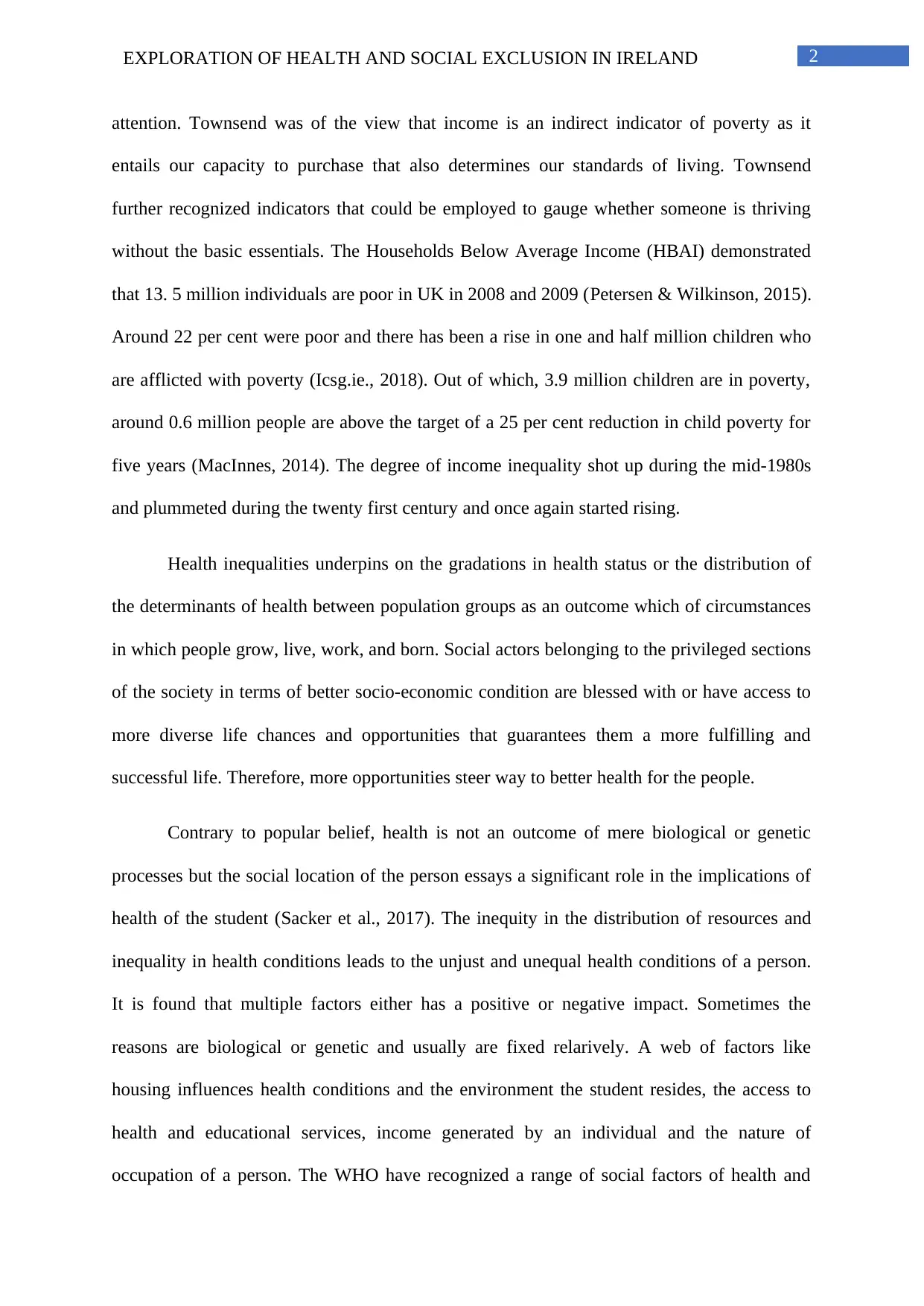
2EXPLORATION OF HEALTH AND SOCIAL EXCLUSION IN IRELAND
attention. Townsend was of the view that income is an indirect indicator of poverty as it
entails our capacity to purchase that also determines our standards of living. Townsend
further recognized indicators that could be employed to gauge whether someone is thriving
without the basic essentials. The Households Below Average Income (HBAI) demonstrated
that 13. 5 million individuals are poor in UK in 2008 and 2009 (Petersen & Wilkinson, 2015).
Around 22 per cent were poor and there has been a rise in one and half million children who
are afflicted with poverty (Icsg.ie., 2018). Out of which, 3.9 million children are in poverty,
around 0.6 million people are above the target of a 25 per cent reduction in child poverty for
five years (MacInnes, 2014). The degree of income inequality shot up during the mid-1980s
and plummeted during the twenty first century and once again started rising.
Health inequalities underpins on the gradations in health status or the distribution of
the determinants of health between population groups as an outcome which of circumstances
in which people grow, live, work, and born. Social actors belonging to the privileged sections
of the society in terms of better socio-economic condition are blessed with or have access to
more diverse life chances and opportunities that guarantees them a more fulfilling and
successful life. Therefore, more opportunities steer way to better health for the people.
Contrary to popular belief, health is not an outcome of mere biological or genetic
processes but the social location of the person essays a significant role in the implications of
health of the student (Sacker et al., 2017). The inequity in the distribution of resources and
inequality in health conditions leads to the unjust and unequal health conditions of a person.
It is found that multiple factors either has a positive or negative impact. Sometimes the
reasons are biological or genetic and usually are fixed relarively. A web of factors like
housing influences health conditions and the environment the student resides, the access to
health and educational services, income generated by an individual and the nature of
occupation of a person. The WHO have recognized a range of social factors of health and
attention. Townsend was of the view that income is an indirect indicator of poverty as it
entails our capacity to purchase that also determines our standards of living. Townsend
further recognized indicators that could be employed to gauge whether someone is thriving
without the basic essentials. The Households Below Average Income (HBAI) demonstrated
that 13. 5 million individuals are poor in UK in 2008 and 2009 (Petersen & Wilkinson, 2015).
Around 22 per cent were poor and there has been a rise in one and half million children who
are afflicted with poverty (Icsg.ie., 2018). Out of which, 3.9 million children are in poverty,
around 0.6 million people are above the target of a 25 per cent reduction in child poverty for
five years (MacInnes, 2014). The degree of income inequality shot up during the mid-1980s
and plummeted during the twenty first century and once again started rising.
Health inequalities underpins on the gradations in health status or the distribution of
the determinants of health between population groups as an outcome which of circumstances
in which people grow, live, work, and born. Social actors belonging to the privileged sections
of the society in terms of better socio-economic condition are blessed with or have access to
more diverse life chances and opportunities that guarantees them a more fulfilling and
successful life. Therefore, more opportunities steer way to better health for the people.
Contrary to popular belief, health is not an outcome of mere biological or genetic
processes but the social location of the person essays a significant role in the implications of
health of the student (Sacker et al., 2017). The inequity in the distribution of resources and
inequality in health conditions leads to the unjust and unequal health conditions of a person.
It is found that multiple factors either has a positive or negative impact. Sometimes the
reasons are biological or genetic and usually are fixed relarively. A web of factors like
housing influences health conditions and the environment the student resides, the access to
health and educational services, income generated by an individual and the nature of
occupation of a person. The WHO have recognized a range of social factors of health and
⊘ This is a preview!⊘
Do you want full access?
Subscribe today to unlock all pages.

Trusted by 1+ million students worldwide
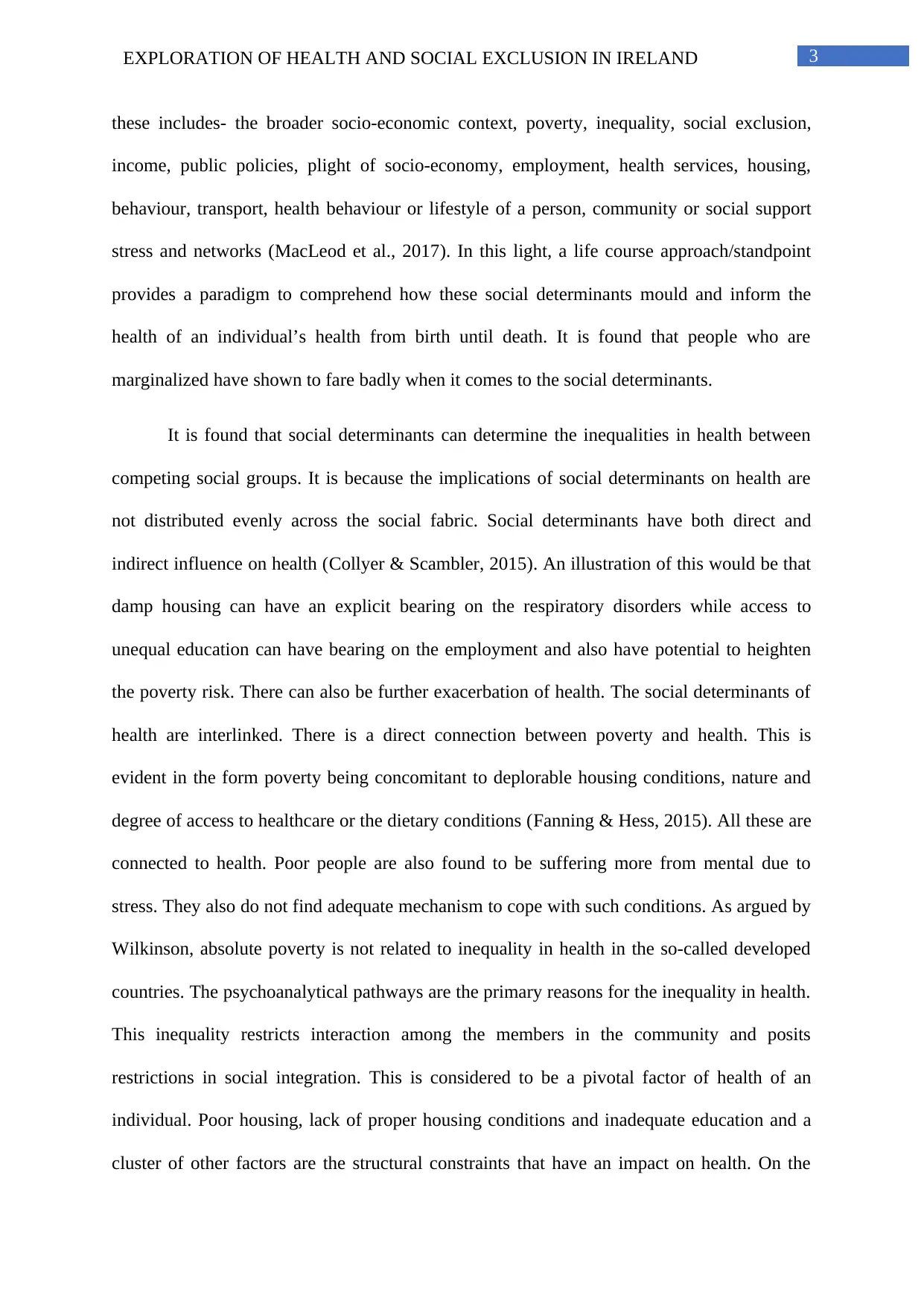
3EXPLORATION OF HEALTH AND SOCIAL EXCLUSION IN IRELAND
these includes- the broader socio-economic context, poverty, inequality, social exclusion,
income, public policies, plight of socio-economy, employment, health services, housing,
behaviour, transport, health behaviour or lifestyle of a person, community or social support
stress and networks (MacLeod et al., 2017). In this light, a life course approach/standpoint
provides a paradigm to comprehend how these social determinants mould and inform the
health of an individual’s health from birth until death. It is found that people who are
marginalized have shown to fare badly when it comes to the social determinants.
It is found that social determinants can determine the inequalities in health between
competing social groups. It is because the implications of social determinants on health are
not distributed evenly across the social fabric. Social determinants have both direct and
indirect influence on health (Collyer & Scambler, 2015). An illustration of this would be that
damp housing can have an explicit bearing on the respiratory disorders while access to
unequal education can have bearing on the employment and also have potential to heighten
the poverty risk. There can also be further exacerbation of health. The social determinants of
health are interlinked. There is a direct connection between poverty and health. This is
evident in the form poverty being concomitant to deplorable housing conditions, nature and
degree of access to healthcare or the dietary conditions (Fanning & Hess, 2015). All these are
connected to health. Poor people are also found to be suffering more from mental due to
stress. They also do not find adequate mechanism to cope with such conditions. As argued by
Wilkinson, absolute poverty is not related to inequality in health in the so-called developed
countries. The psychoanalytical pathways are the primary reasons for the inequality in health.
This inequality restricts interaction among the members in the community and posits
restrictions in social integration. This is considered to be a pivotal factor of health of an
individual. Poor housing, lack of proper housing conditions and inadequate education and a
cluster of other factors are the structural constraints that have an impact on health. On the
these includes- the broader socio-economic context, poverty, inequality, social exclusion,
income, public policies, plight of socio-economy, employment, health services, housing,
behaviour, transport, health behaviour or lifestyle of a person, community or social support
stress and networks (MacLeod et al., 2017). In this light, a life course approach/standpoint
provides a paradigm to comprehend how these social determinants mould and inform the
health of an individual’s health from birth until death. It is found that people who are
marginalized have shown to fare badly when it comes to the social determinants.
It is found that social determinants can determine the inequalities in health between
competing social groups. It is because the implications of social determinants on health are
not distributed evenly across the social fabric. Social determinants have both direct and
indirect influence on health (Collyer & Scambler, 2015). An illustration of this would be that
damp housing can have an explicit bearing on the respiratory disorders while access to
unequal education can have bearing on the employment and also have potential to heighten
the poverty risk. There can also be further exacerbation of health. The social determinants of
health are interlinked. There is a direct connection between poverty and health. This is
evident in the form poverty being concomitant to deplorable housing conditions, nature and
degree of access to healthcare or the dietary conditions (Fanning & Hess, 2015). All these are
connected to health. Poor people are also found to be suffering more from mental due to
stress. They also do not find adequate mechanism to cope with such conditions. As argued by
Wilkinson, absolute poverty is not related to inequality in health in the so-called developed
countries. The psychoanalytical pathways are the primary reasons for the inequality in health.
This inequality restricts interaction among the members in the community and posits
restrictions in social integration. This is considered to be a pivotal factor of health of an
individual. Poor housing, lack of proper housing conditions and inadequate education and a
cluster of other factors are the structural constraints that have an impact on health. On the
Paraphrase This Document
Need a fresh take? Get an instant paraphrase of this document with our AI Paraphraser
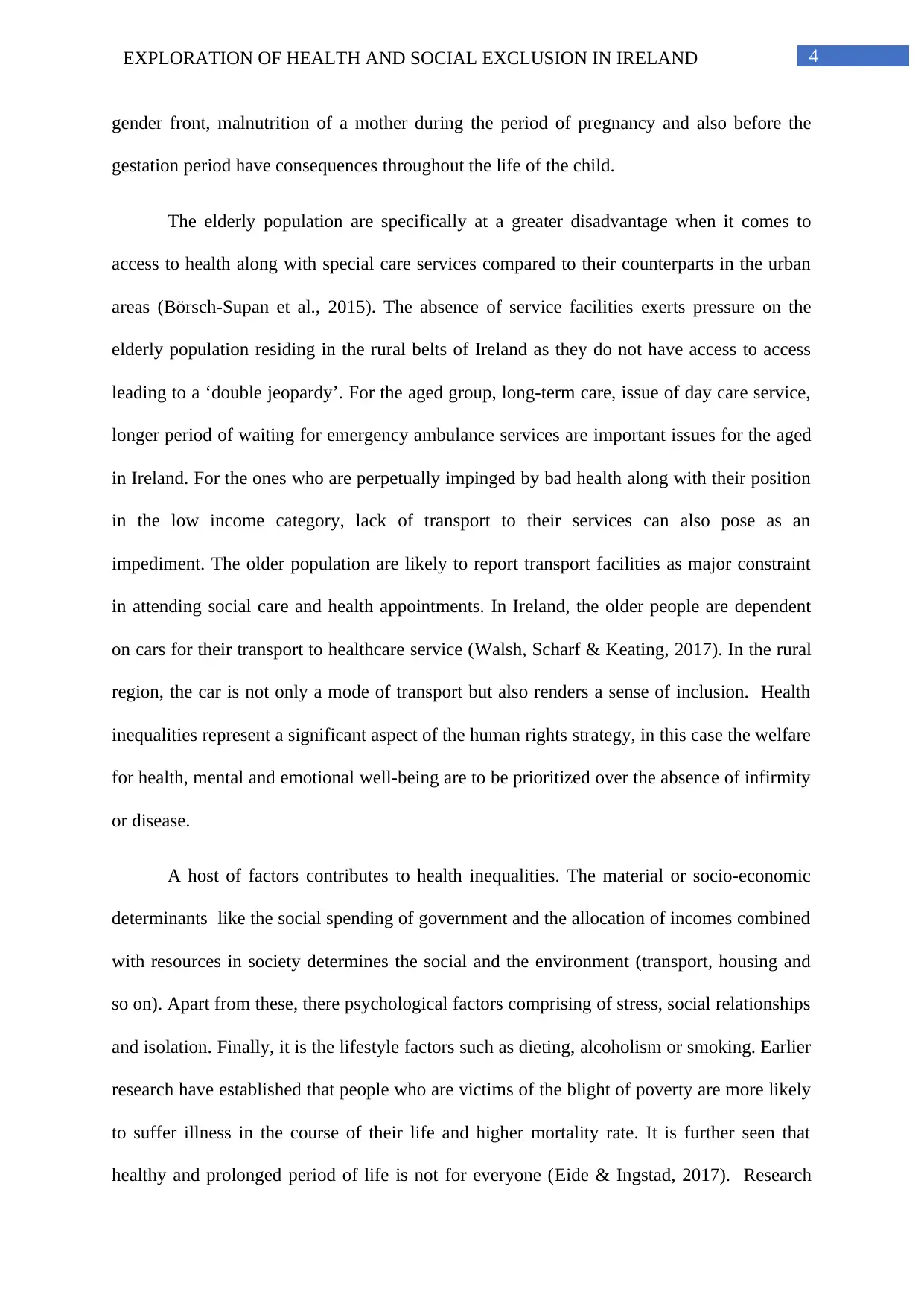
4EXPLORATION OF HEALTH AND SOCIAL EXCLUSION IN IRELAND
gender front, malnutrition of a mother during the period of pregnancy and also before the
gestation period have consequences throughout the life of the child.
The elderly population are specifically at a greater disadvantage when it comes to
access to health along with special care services compared to their counterparts in the urban
areas (Börsch-Supan et al., 2015). The absence of service facilities exerts pressure on the
elderly population residing in the rural belts of Ireland as they do not have access to access
leading to a ‘double jeopardy’. For the aged group, long-term care, issue of day care service,
longer period of waiting for emergency ambulance services are important issues for the aged
in Ireland. For the ones who are perpetually impinged by bad health along with their position
in the low income category, lack of transport to their services can also pose as an
impediment. The older population are likely to report transport facilities as major constraint
in attending social care and health appointments. In Ireland, the older people are dependent
on cars for their transport to healthcare service (Walsh, Scharf & Keating, 2017). In the rural
region, the car is not only a mode of transport but also renders a sense of inclusion. Health
inequalities represent a significant aspect of the human rights strategy, in this case the welfare
for health, mental and emotional well-being are to be prioritized over the absence of infirmity
or disease.
A host of factors contributes to health inequalities. The material or socio-economic
determinants like the social spending of government and the allocation of incomes combined
with resources in society determines the social and the environment (transport, housing and
so on). Apart from these, there psychological factors comprising of stress, social relationships
and isolation. Finally, it is the lifestyle factors such as dieting, alcoholism or smoking. Earlier
research have established that people who are victims of the blight of poverty are more likely
to suffer illness in the course of their life and higher mortality rate. It is further seen that
healthy and prolonged period of life is not for everyone (Eide & Ingstad, 2017). Research
gender front, malnutrition of a mother during the period of pregnancy and also before the
gestation period have consequences throughout the life of the child.
The elderly population are specifically at a greater disadvantage when it comes to
access to health along with special care services compared to their counterparts in the urban
areas (Börsch-Supan et al., 2015). The absence of service facilities exerts pressure on the
elderly population residing in the rural belts of Ireland as they do not have access to access
leading to a ‘double jeopardy’. For the aged group, long-term care, issue of day care service,
longer period of waiting for emergency ambulance services are important issues for the aged
in Ireland. For the ones who are perpetually impinged by bad health along with their position
in the low income category, lack of transport to their services can also pose as an
impediment. The older population are likely to report transport facilities as major constraint
in attending social care and health appointments. In Ireland, the older people are dependent
on cars for their transport to healthcare service (Walsh, Scharf & Keating, 2017). In the rural
region, the car is not only a mode of transport but also renders a sense of inclusion. Health
inequalities represent a significant aspect of the human rights strategy, in this case the welfare
for health, mental and emotional well-being are to be prioritized over the absence of infirmity
or disease.
A host of factors contributes to health inequalities. The material or socio-economic
determinants like the social spending of government and the allocation of incomes combined
with resources in society determines the social and the environment (transport, housing and
so on). Apart from these, there psychological factors comprising of stress, social relationships
and isolation. Finally, it is the lifestyle factors such as dieting, alcoholism or smoking. Earlier
research have established that people who are victims of the blight of poverty are more likely
to suffer illness in the course of their life and higher mortality rate. It is further seen that
healthy and prolonged period of life is not for everyone (Eide & Ingstad, 2017). Research
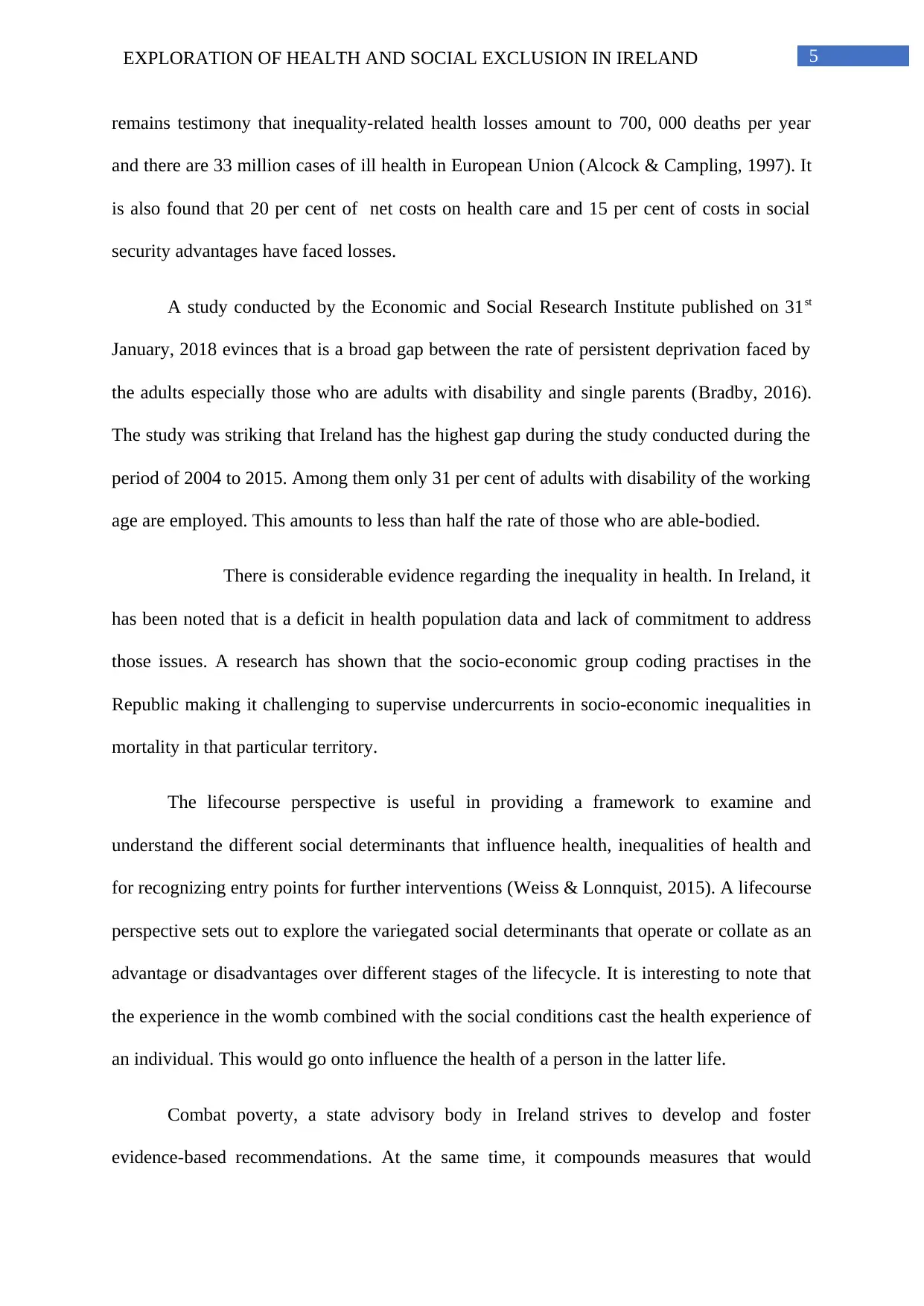
5EXPLORATION OF HEALTH AND SOCIAL EXCLUSION IN IRELAND
remains testimony that inequality-related health losses amount to 700, 000 deaths per year
and there are 33 million cases of ill health in European Union (Alcock & Campling, 1997). It
is also found that 20 per cent of net costs on health care and 15 per cent of costs in social
security advantages have faced losses.
A study conducted by the Economic and Social Research Institute published on 31st
January, 2018 evinces that is a broad gap between the rate of persistent deprivation faced by
the adults especially those who are adults with disability and single parents (Bradby, 2016).
The study was striking that Ireland has the highest gap during the study conducted during the
period of 2004 to 2015. Among them only 31 per cent of adults with disability of the working
age are employed. This amounts to less than half the rate of those who are able-bodied.
There is considerable evidence regarding the inequality in health. In Ireland, it
has been noted that is a deficit in health population data and lack of commitment to address
those issues. A research has shown that the socio-economic group coding practises in the
Republic making it challenging to supervise undercurrents in socio-economic inequalities in
mortality in that particular territory.
The lifecourse perspective is useful in providing a framework to examine and
understand the different social determinants that influence health, inequalities of health and
for recognizing entry points for further interventions (Weiss & Lonnquist, 2015). A lifecourse
perspective sets out to explore the variegated social determinants that operate or collate as an
advantage or disadvantages over different stages of the lifecycle. It is interesting to note that
the experience in the womb combined with the social conditions cast the health experience of
an individual. This would go onto influence the health of a person in the latter life.
Combat poverty, a state advisory body in Ireland strives to develop and foster
evidence-based recommendations. At the same time, it compounds measures that would
remains testimony that inequality-related health losses amount to 700, 000 deaths per year
and there are 33 million cases of ill health in European Union (Alcock & Campling, 1997). It
is also found that 20 per cent of net costs on health care and 15 per cent of costs in social
security advantages have faced losses.
A study conducted by the Economic and Social Research Institute published on 31st
January, 2018 evinces that is a broad gap between the rate of persistent deprivation faced by
the adults especially those who are adults with disability and single parents (Bradby, 2016).
The study was striking that Ireland has the highest gap during the study conducted during the
period of 2004 to 2015. Among them only 31 per cent of adults with disability of the working
age are employed. This amounts to less than half the rate of those who are able-bodied.
There is considerable evidence regarding the inequality in health. In Ireland, it
has been noted that is a deficit in health population data and lack of commitment to address
those issues. A research has shown that the socio-economic group coding practises in the
Republic making it challenging to supervise undercurrents in socio-economic inequalities in
mortality in that particular territory.
The lifecourse perspective is useful in providing a framework to examine and
understand the different social determinants that influence health, inequalities of health and
for recognizing entry points for further interventions (Weiss & Lonnquist, 2015). A lifecourse
perspective sets out to explore the variegated social determinants that operate or collate as an
advantage or disadvantages over different stages of the lifecycle. It is interesting to note that
the experience in the womb combined with the social conditions cast the health experience of
an individual. This would go onto influence the health of a person in the latter life.
Combat poverty, a state advisory body in Ireland strives to develop and foster
evidence-based recommendations. At the same time, it compounds measures that would
⊘ This is a preview!⊘
Do you want full access?
Subscribe today to unlock all pages.

Trusted by 1+ million students worldwide
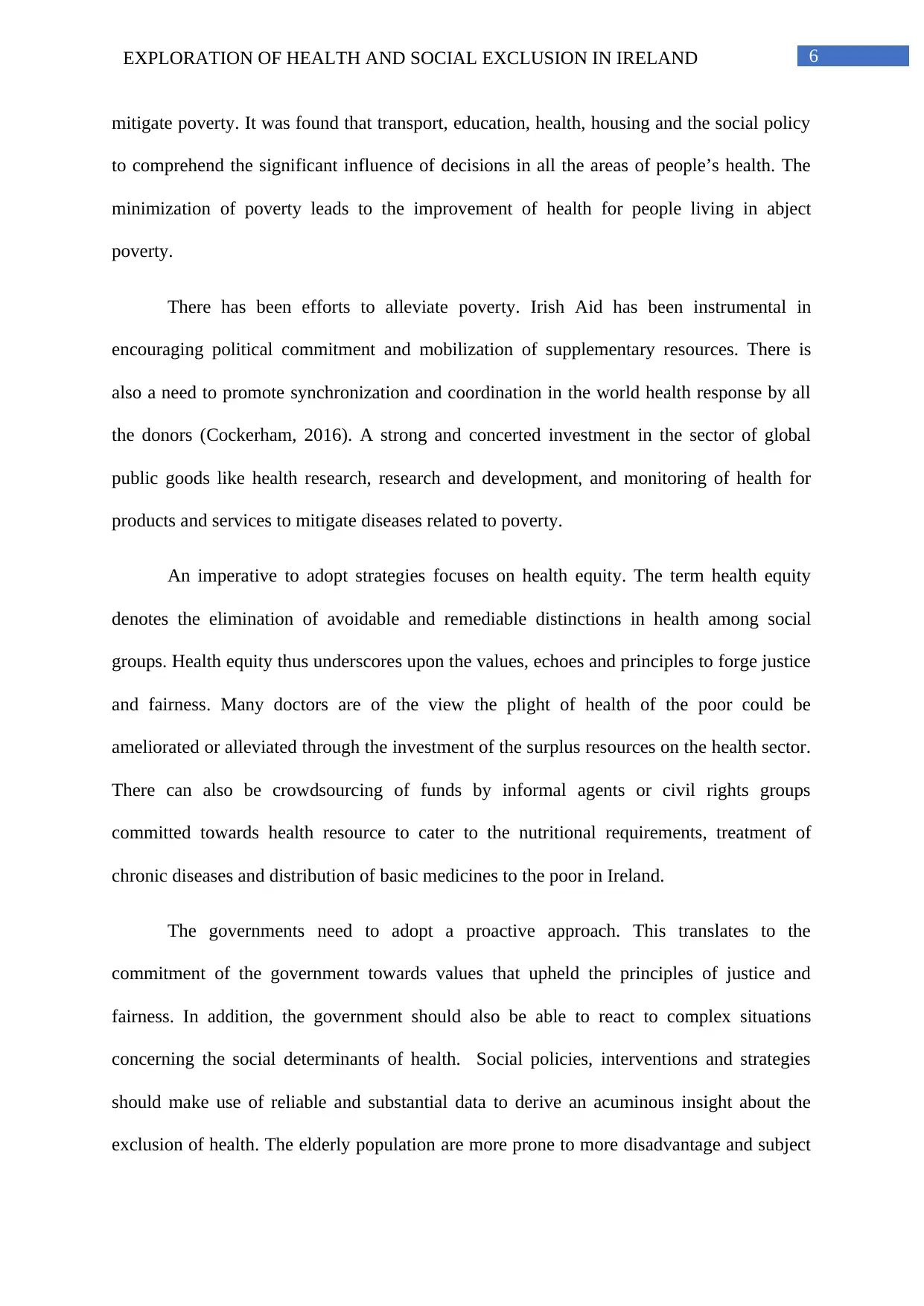
6EXPLORATION OF HEALTH AND SOCIAL EXCLUSION IN IRELAND
mitigate poverty. It was found that transport, education, health, housing and the social policy
to comprehend the significant influence of decisions in all the areas of people’s health. The
minimization of poverty leads to the improvement of health for people living in abject
poverty.
There has been efforts to alleviate poverty. Irish Aid has been instrumental in
encouraging political commitment and mobilization of supplementary resources. There is
also a need to promote synchronization and coordination in the world health response by all
the donors (Cockerham, 2016). A strong and concerted investment in the sector of global
public goods like health research, research and development, and monitoring of health for
products and services to mitigate diseases related to poverty.
An imperative to adopt strategies focuses on health equity. The term health equity
denotes the elimination of avoidable and remediable distinctions in health among social
groups. Health equity thus underscores upon the values, echoes and principles to forge justice
and fairness. Many doctors are of the view the plight of health of the poor could be
ameliorated or alleviated through the investment of the surplus resources on the health sector.
There can also be crowdsourcing of funds by informal agents or civil rights groups
committed towards health resource to cater to the nutritional requirements, treatment of
chronic diseases and distribution of basic medicines to the poor in Ireland.
The governments need to adopt a proactive approach. This translates to the
commitment of the government towards values that upheld the principles of justice and
fairness. In addition, the government should also be able to react to complex situations
concerning the social determinants of health. Social policies, interventions and strategies
should make use of reliable and substantial data to derive an acuminous insight about the
exclusion of health. The elderly population are more prone to more disadvantage and subject
mitigate poverty. It was found that transport, education, health, housing and the social policy
to comprehend the significant influence of decisions in all the areas of people’s health. The
minimization of poverty leads to the improvement of health for people living in abject
poverty.
There has been efforts to alleviate poverty. Irish Aid has been instrumental in
encouraging political commitment and mobilization of supplementary resources. There is
also a need to promote synchronization and coordination in the world health response by all
the donors (Cockerham, 2016). A strong and concerted investment in the sector of global
public goods like health research, research and development, and monitoring of health for
products and services to mitigate diseases related to poverty.
An imperative to adopt strategies focuses on health equity. The term health equity
denotes the elimination of avoidable and remediable distinctions in health among social
groups. Health equity thus underscores upon the values, echoes and principles to forge justice
and fairness. Many doctors are of the view the plight of health of the poor could be
ameliorated or alleviated through the investment of the surplus resources on the health sector.
There can also be crowdsourcing of funds by informal agents or civil rights groups
committed towards health resource to cater to the nutritional requirements, treatment of
chronic diseases and distribution of basic medicines to the poor in Ireland.
The governments need to adopt a proactive approach. This translates to the
commitment of the government towards values that upheld the principles of justice and
fairness. In addition, the government should also be able to react to complex situations
concerning the social determinants of health. Social policies, interventions and strategies
should make use of reliable and substantial data to derive an acuminous insight about the
exclusion of health. The elderly population are more prone to more disadvantage and subject
Paraphrase This Document
Need a fresh take? Get an instant paraphrase of this document with our AI Paraphraser
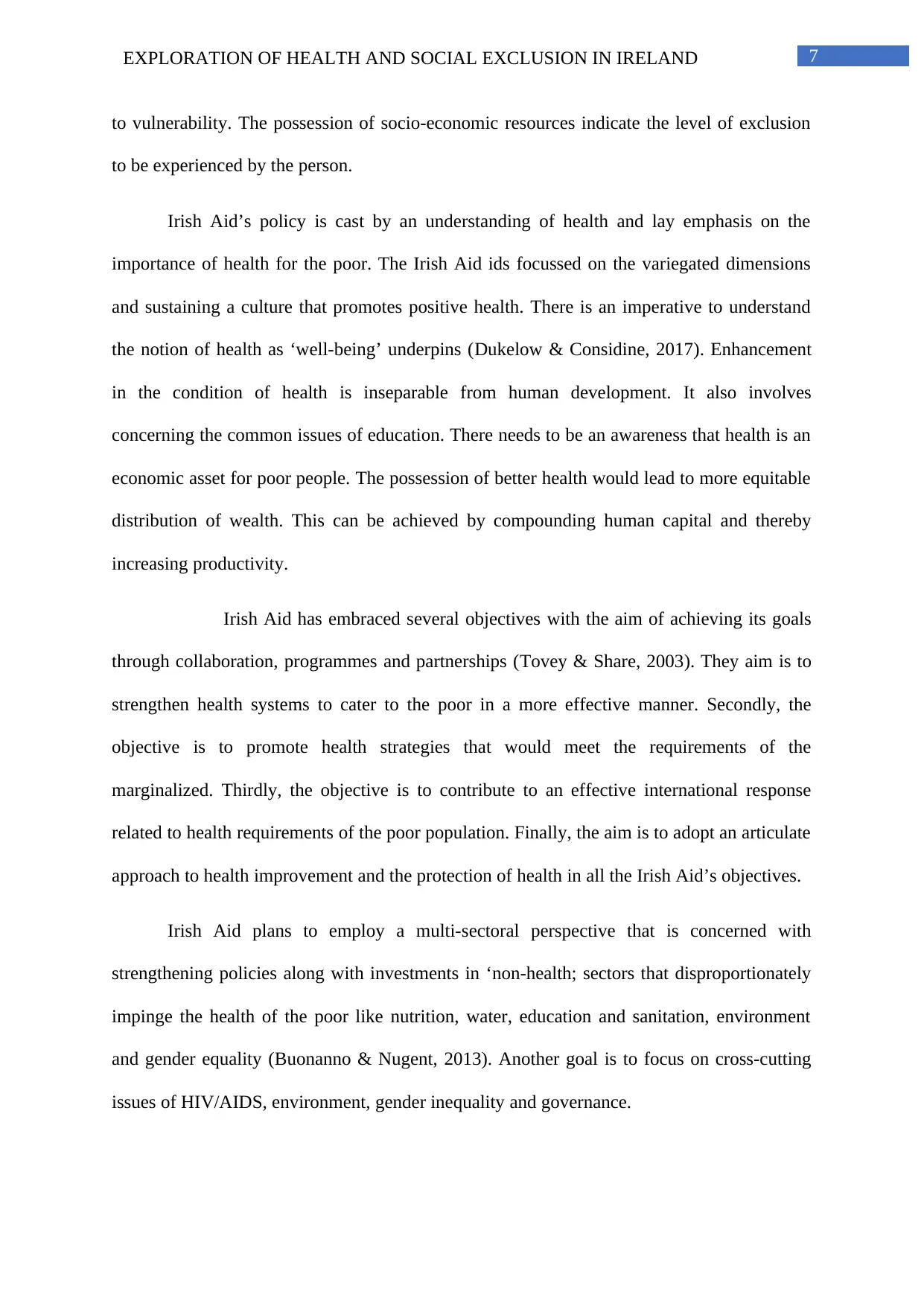
7EXPLORATION OF HEALTH AND SOCIAL EXCLUSION IN IRELAND
to vulnerability. The possession of socio-economic resources indicate the level of exclusion
to be experienced by the person.
Irish Aid’s policy is cast by an understanding of health and lay emphasis on the
importance of health for the poor. The Irish Aid ids focussed on the variegated dimensions
and sustaining a culture that promotes positive health. There is an imperative to understand
the notion of health as ‘well-being’ underpins (Dukelow & Considine, 2017). Enhancement
in the condition of health is inseparable from human development. It also involves
concerning the common issues of education. There needs to be an awareness that health is an
economic asset for poor people. The possession of better health would lead to more equitable
distribution of wealth. This can be achieved by compounding human capital and thereby
increasing productivity.
Irish Aid has embraced several objectives with the aim of achieving its goals
through collaboration, programmes and partnerships (Tovey & Share, 2003). They aim is to
strengthen health systems to cater to the poor in a more effective manner. Secondly, the
objective is to promote health strategies that would meet the requirements of the
marginalized. Thirdly, the objective is to contribute to an effective international response
related to health requirements of the poor population. Finally, the aim is to adopt an articulate
approach to health improvement and the protection of health in all the Irish Aid’s objectives.
Irish Aid plans to employ a multi-sectoral perspective that is concerned with
strengthening policies along with investments in ‘non-health; sectors that disproportionately
impinge the health of the poor like nutrition, water, education and sanitation, environment
and gender equality (Buonanno & Nugent, 2013). Another goal is to focus on cross-cutting
issues of HIV/AIDS, environment, gender inequality and governance.
to vulnerability. The possession of socio-economic resources indicate the level of exclusion
to be experienced by the person.
Irish Aid’s policy is cast by an understanding of health and lay emphasis on the
importance of health for the poor. The Irish Aid ids focussed on the variegated dimensions
and sustaining a culture that promotes positive health. There is an imperative to understand
the notion of health as ‘well-being’ underpins (Dukelow & Considine, 2017). Enhancement
in the condition of health is inseparable from human development. It also involves
concerning the common issues of education. There needs to be an awareness that health is an
economic asset for poor people. The possession of better health would lead to more equitable
distribution of wealth. This can be achieved by compounding human capital and thereby
increasing productivity.
Irish Aid has embraced several objectives with the aim of achieving its goals
through collaboration, programmes and partnerships (Tovey & Share, 2003). They aim is to
strengthen health systems to cater to the poor in a more effective manner. Secondly, the
objective is to promote health strategies that would meet the requirements of the
marginalized. Thirdly, the objective is to contribute to an effective international response
related to health requirements of the poor population. Finally, the aim is to adopt an articulate
approach to health improvement and the protection of health in all the Irish Aid’s objectives.
Irish Aid plans to employ a multi-sectoral perspective that is concerned with
strengthening policies along with investments in ‘non-health; sectors that disproportionately
impinge the health of the poor like nutrition, water, education and sanitation, environment
and gender equality (Buonanno & Nugent, 2013). Another goal is to focus on cross-cutting
issues of HIV/AIDS, environment, gender inequality and governance.
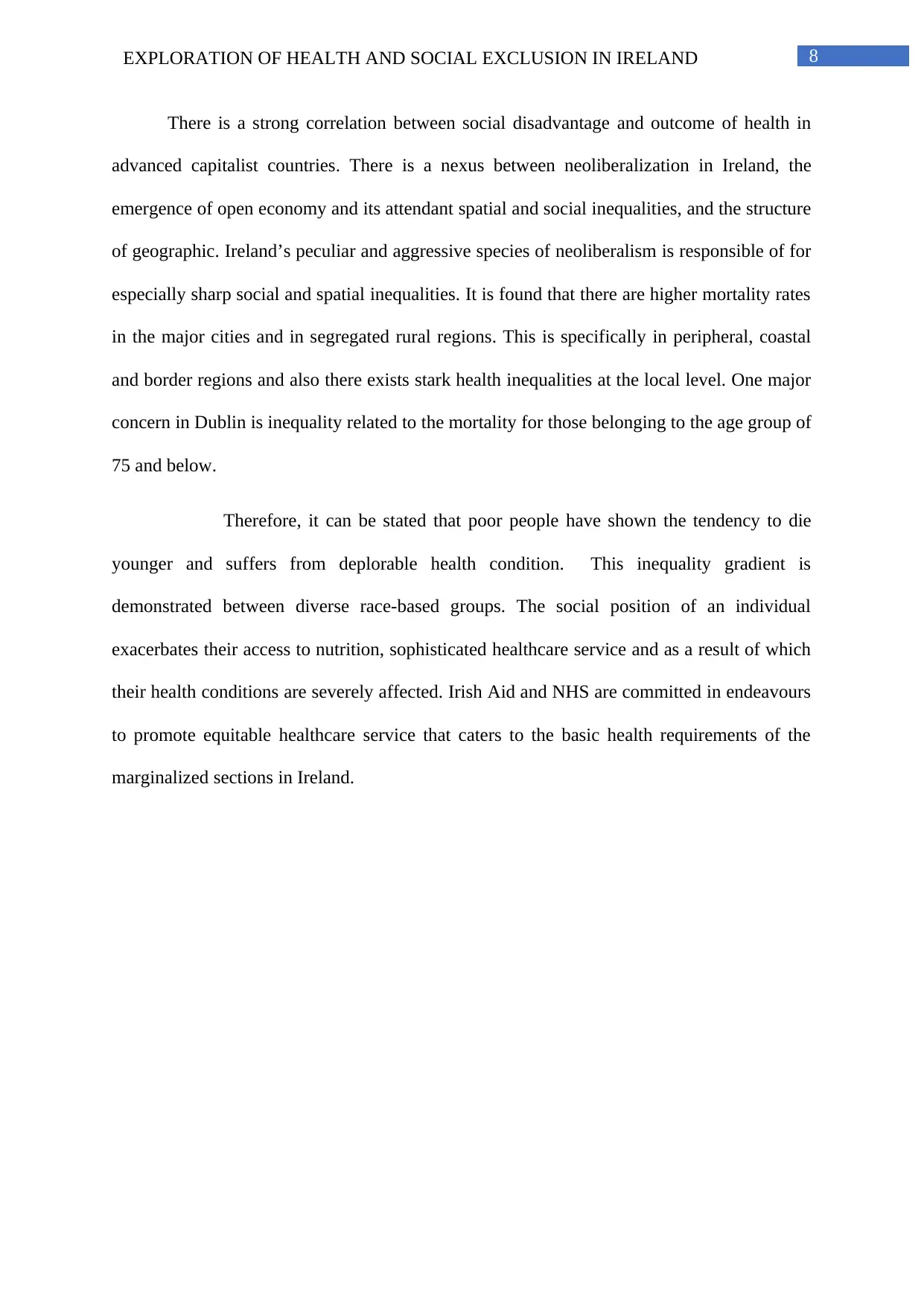
8EXPLORATION OF HEALTH AND SOCIAL EXCLUSION IN IRELAND
There is a strong correlation between social disadvantage and outcome of health in
advanced capitalist countries. There is a nexus between neoliberalization in Ireland, the
emergence of open economy and its attendant spatial and social inequalities, and the structure
of geographic. Ireland’s peculiar and aggressive species of neoliberalism is responsible of for
especially sharp social and spatial inequalities. It is found that there are higher mortality rates
in the major cities and in segregated rural regions. This is specifically in peripheral, coastal
and border regions and also there exists stark health inequalities at the local level. One major
concern in Dublin is inequality related to the mortality for those belonging to the age group of
75 and below.
Therefore, it can be stated that poor people have shown the tendency to die
younger and suffers from deplorable health condition. This inequality gradient is
demonstrated between diverse race-based groups. The social position of an individual
exacerbates their access to nutrition, sophisticated healthcare service and as a result of which
their health conditions are severely affected. Irish Aid and NHS are committed in endeavours
to promote equitable healthcare service that caters to the basic health requirements of the
marginalized sections in Ireland.
There is a strong correlation between social disadvantage and outcome of health in
advanced capitalist countries. There is a nexus between neoliberalization in Ireland, the
emergence of open economy and its attendant spatial and social inequalities, and the structure
of geographic. Ireland’s peculiar and aggressive species of neoliberalism is responsible of for
especially sharp social and spatial inequalities. It is found that there are higher mortality rates
in the major cities and in segregated rural regions. This is specifically in peripheral, coastal
and border regions and also there exists stark health inequalities at the local level. One major
concern in Dublin is inequality related to the mortality for those belonging to the age group of
75 and below.
Therefore, it can be stated that poor people have shown the tendency to die
younger and suffers from deplorable health condition. This inequality gradient is
demonstrated between diverse race-based groups. The social position of an individual
exacerbates their access to nutrition, sophisticated healthcare service and as a result of which
their health conditions are severely affected. Irish Aid and NHS are committed in endeavours
to promote equitable healthcare service that caters to the basic health requirements of the
marginalized sections in Ireland.
⊘ This is a preview!⊘
Do you want full access?
Subscribe today to unlock all pages.

Trusted by 1+ million students worldwide
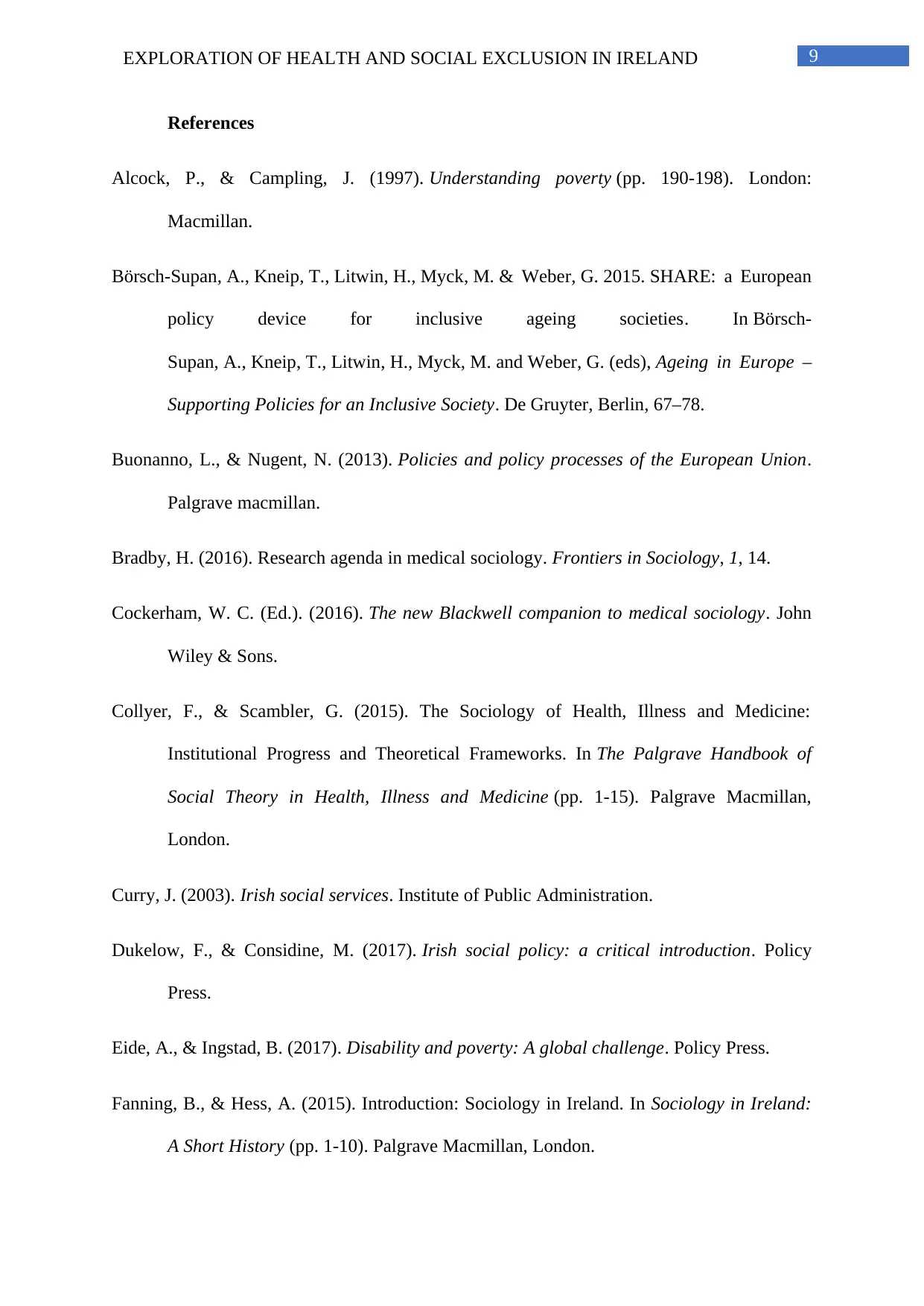
9EXPLORATION OF HEALTH AND SOCIAL EXCLUSION IN IRELAND
References
Alcock, P., & Campling, J. (1997). Understanding poverty (pp. 190-198). London:
Macmillan.
Börsch-Supan, A., Kneip, T., Litwin, H., Myck, M. & Weber, G. 2015. SHARE: a European
policy device for inclusive ageing societies. In Börsch-
Supan, A., Kneip, T., Litwin, H., Myck, M. and Weber, G. (eds), Ageing in Europe –
Supporting Policies for an Inclusive Society. De Gruyter, Berlin, 67–78.
Buonanno, L., & Nugent, N. (2013). Policies and policy processes of the European Union.
Palgrave macmillan.
Bradby, H. (2016). Research agenda in medical sociology. Frontiers in Sociology, 1, 14.
Cockerham, W. C. (Ed.). (2016). The new Blackwell companion to medical sociology. John
Wiley & Sons.
Collyer, F., & Scambler, G. (2015). The Sociology of Health, Illness and Medicine:
Institutional Progress and Theoretical Frameworks. In The Palgrave Handbook of
Social Theory in Health, Illness and Medicine (pp. 1-15). Palgrave Macmillan,
London.
Curry, J. (2003). Irish social services. Institute of Public Administration.
Dukelow, F., & Considine, M. (2017). Irish social policy: a critical introduction. Policy
Press.
Eide, A., & Ingstad, B. (2017). Disability and poverty: A global challenge. Policy Press.
Fanning, B., & Hess, A. (2015). Introduction: Sociology in Ireland. In Sociology in Ireland:
A Short History (pp. 1-10). Palgrave Macmillan, London.
References
Alcock, P., & Campling, J. (1997). Understanding poverty (pp. 190-198). London:
Macmillan.
Börsch-Supan, A., Kneip, T., Litwin, H., Myck, M. & Weber, G. 2015. SHARE: a European
policy device for inclusive ageing societies. In Börsch-
Supan, A., Kneip, T., Litwin, H., Myck, M. and Weber, G. (eds), Ageing in Europe –
Supporting Policies for an Inclusive Society. De Gruyter, Berlin, 67–78.
Buonanno, L., & Nugent, N. (2013). Policies and policy processes of the European Union.
Palgrave macmillan.
Bradby, H. (2016). Research agenda in medical sociology. Frontiers in Sociology, 1, 14.
Cockerham, W. C. (Ed.). (2016). The new Blackwell companion to medical sociology. John
Wiley & Sons.
Collyer, F., & Scambler, G. (2015). The Sociology of Health, Illness and Medicine:
Institutional Progress and Theoretical Frameworks. In The Palgrave Handbook of
Social Theory in Health, Illness and Medicine (pp. 1-15). Palgrave Macmillan,
London.
Curry, J. (2003). Irish social services. Institute of Public Administration.
Dukelow, F., & Considine, M. (2017). Irish social policy: a critical introduction. Policy
Press.
Eide, A., & Ingstad, B. (2017). Disability and poverty: A global challenge. Policy Press.
Fanning, B., & Hess, A. (2015). Introduction: Sociology in Ireland. In Sociology in Ireland:
A Short History (pp. 1-10). Palgrave Macmillan, London.
Paraphrase This Document
Need a fresh take? Get an instant paraphrase of this document with our AI Paraphraser
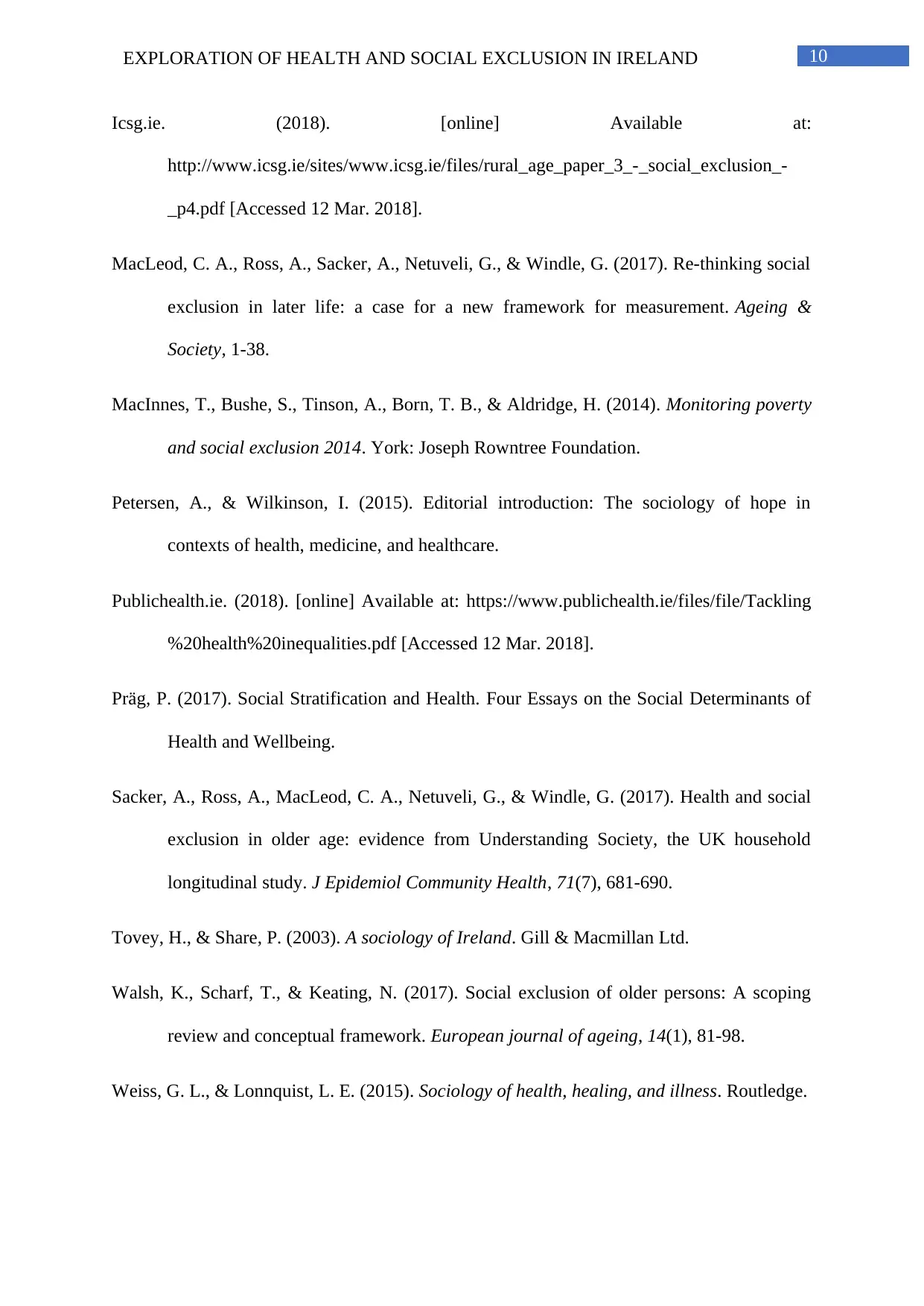
10EXPLORATION OF HEALTH AND SOCIAL EXCLUSION IN IRELAND
Icsg.ie. (2018). [online] Available at:
http://www.icsg.ie/sites/www.icsg.ie/files/rural_age_paper_3_-_social_exclusion_-
_p4.pdf [Accessed 12 Mar. 2018].
MacLeod, C. A., Ross, A., Sacker, A., Netuveli, G., & Windle, G. (2017). Re-thinking social
exclusion in later life: a case for a new framework for measurement. Ageing &
Society, 1-38.
MacInnes, T., Bushe, S., Tinson, A., Born, T. B., & Aldridge, H. (2014). Monitoring poverty
and social exclusion 2014. York: Joseph Rowntree Foundation.
Petersen, A., & Wilkinson, I. (2015). Editorial introduction: The sociology of hope in
contexts of health, medicine, and healthcare.
Publichealth.ie. (2018). [online] Available at: https://www.publichealth.ie/files/file/Tackling
%20health%20inequalities.pdf [Accessed 12 Mar. 2018].
Präg, P. (2017). Social Stratification and Health. Four Essays on the Social Determinants of
Health and Wellbeing.
Sacker, A., Ross, A., MacLeod, C. A., Netuveli, G., & Windle, G. (2017). Health and social
exclusion in older age: evidence from Understanding Society, the UK household
longitudinal study. J Epidemiol Community Health, 71(7), 681-690.
Tovey, H., & Share, P. (2003). A sociology of Ireland. Gill & Macmillan Ltd.
Walsh, K., Scharf, T., & Keating, N. (2017). Social exclusion of older persons: A scoping
review and conceptual framework. European journal of ageing, 14(1), 81-98.
Weiss, G. L., & Lonnquist, L. E. (2015). Sociology of health, healing, and illness. Routledge.
Icsg.ie. (2018). [online] Available at:
http://www.icsg.ie/sites/www.icsg.ie/files/rural_age_paper_3_-_social_exclusion_-
_p4.pdf [Accessed 12 Mar. 2018].
MacLeod, C. A., Ross, A., Sacker, A., Netuveli, G., & Windle, G. (2017). Re-thinking social
exclusion in later life: a case for a new framework for measurement. Ageing &
Society, 1-38.
MacInnes, T., Bushe, S., Tinson, A., Born, T. B., & Aldridge, H. (2014). Monitoring poverty
and social exclusion 2014. York: Joseph Rowntree Foundation.
Petersen, A., & Wilkinson, I. (2015). Editorial introduction: The sociology of hope in
contexts of health, medicine, and healthcare.
Publichealth.ie. (2018). [online] Available at: https://www.publichealth.ie/files/file/Tackling
%20health%20inequalities.pdf [Accessed 12 Mar. 2018].
Präg, P. (2017). Social Stratification and Health. Four Essays on the Social Determinants of
Health and Wellbeing.
Sacker, A., Ross, A., MacLeod, C. A., Netuveli, G., & Windle, G. (2017). Health and social
exclusion in older age: evidence from Understanding Society, the UK household
longitudinal study. J Epidemiol Community Health, 71(7), 681-690.
Tovey, H., & Share, P. (2003). A sociology of Ireland. Gill & Macmillan Ltd.
Walsh, K., Scharf, T., & Keating, N. (2017). Social exclusion of older persons: A scoping
review and conceptual framework. European journal of ageing, 14(1), 81-98.
Weiss, G. L., & Lonnquist, L. E. (2015). Sociology of health, healing, and illness. Routledge.
1 out of 11
Related Documents
Your All-in-One AI-Powered Toolkit for Academic Success.
+13062052269
info@desklib.com
Available 24*7 on WhatsApp / Email
![[object Object]](/_next/static/media/star-bottom.7253800d.svg)
Unlock your academic potential
Copyright © 2020–2025 A2Z Services. All Rights Reserved. Developed and managed by ZUCOL.





